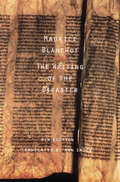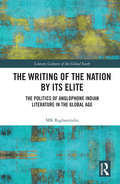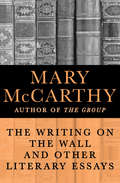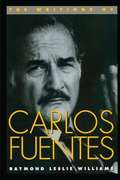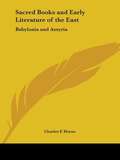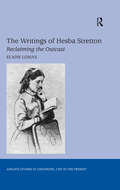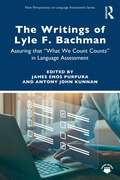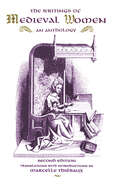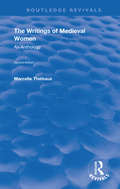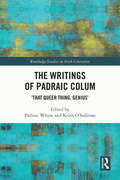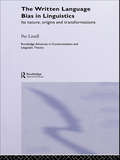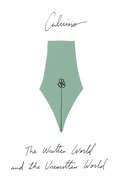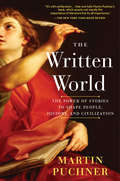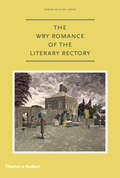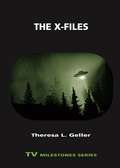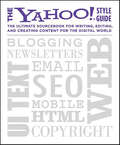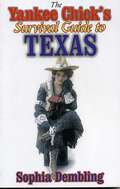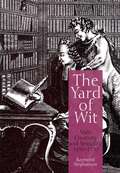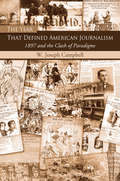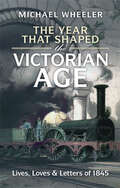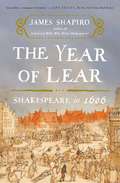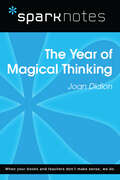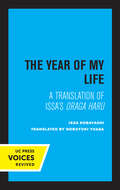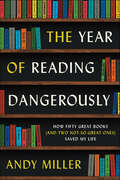- Table View
- List View
The Writing of the Disaster
by Ann Smock Maurice BlanchotModern history is haunted by the disasters of the century—world wars, concentration camps, Hiroshima, and the Holocaust—grief, anger, terror, and loss beyond words, but still close, still impending. How can we write or think about disaster when by its very nature it defies speech and compels silence, burns books and shatters meaning? The Writing of the Disaster reflects upon efforts to abide in disaster’s infinite threat. First published in French in 1980, it takes up the most serious tasks of writing: to describe, explain, and redeem when possible, and to admit what is not possible. Neither offers consolation. Maurice Blanchot has been praised on both sides of the Atlantic for his fiction and criticism. The philosopher Emmanuel Levinas once remarked that Blanchot's writing is a "language of pure transcendence, without correlative." Literary theorist and critic Geoffrey Hartman remarked that Blanchot's influence on contemporary writers "cannot be overestimated."
The Writing of the Nation by Its Elite: The Politics of Anglophone Indian Literature in the Global Age (Literary Cultures of the Global South)
by MK RaghavendraThis volume examines the idea of India as it emerges in the writing of its anglophone elite, post-2000. Drawing on a variety of genres, including fiction, histories, non-fiction assessments – economic, political, and business – travel accounts, and so on, this book maps the explosion of English-language writing in India after the economic liberalization and points to the nation’s sense of its growing importance as a producer of culture. From Ramachandra Guha to William Dalrymple, from Arundhati Roy to Pankaj Mishra, from Jhumpa Lahiri to Amitav Ghosh, from Amartya Sen to Gurcharan Das, from Barkha Dutt to Tarun Tejpal, this investigation takes us from aesthetic imaginings of the nation to its fractured political fault lines, the ideological predispositions of the writers often pointing to an asymmetrically constituted India. A major intervention on how postcolonial India is written about and imagined in the anglophone world, this book will be of great interest to scholars and researchers of cultural studies, literature, history, and South Asian studies. It will also be of interest to general readers with an inclination towards India and Indian writing.
The Writing on the Wall and Other Literary Essays
by Mary MccarthyLiterary criticism that ranges from Shakespeare to Salinger.
The Writing on the Wall: And Other Literary Essays
by Mary McCarthyFrom Madame Bovary to Macbeth, this collection by Mary McCarthy offers surprising revelations about some of the world&’s most beloved worksShakespeare, Nabokov, Orwell, and Burroughs are just a few of the literary immortals featured in this engaging and thought-provoking volume.In one remarkable essay, McCarthy provides a lively discourse on the true nature of evil in Shakespeare&’s plays. Focusing on the character of Macbeth, she reveals why Lady Macbeth, who has to &“unsex herself&” and &“wear the pants,&” is the more human of the two. She tells us why the often-overlooked character of Madame Bovary&’s husband, Charles, is the true hero, and not Emma Bovary, whom Flaubert once famously said was himself. Also included here is McCarthy&’s impassioned defense of Hannah Arendt&’s controversial book Eichmann in Jerusalem, as well as a discussion of the reactionary leftist writers, and a look at why J. D. Salinger was the obvious successor to Hemingway.Distinguished by McCarthy&’s savage intelligence, clarity of thought, and utter lack of pretension, The Writing on the Wall is a timeless gem from an author who reveres the written word.This ebook features an illustrated biography of Mary McCarthy including rare images from the author&’s estate.
The Writings of Carlos Fuentes
by Raymond Leslie WilliamsSmitten by the modernity of Cervantes and Borges at an early age, Carlos Fuentes has written extensively on the cultures of the Americas and elsewhere. His work includes over a dozen novels, among them The Death of Artemio Cruz, Christopher Unborn, The Old Gringo, and Terra Nostra, several volumes of short stories, numerous essays on literary, cultural, and political topics, and some theater. In this book, Raymond Leslie Williams traces the themes of history, culture, and identity in Fuentes' work, particularly in his complex, major novel Terra Nostra. He opens with a biography of Fuentes that links his works to his intellectual life. The heart of the study is Williams' extensive reading of the novel Terra Nostra, in which Fuentes explores the presence of Spanish culture and history in Latin America. Williams concludes with a look at how Fuentes' other fiction relates to Terra Nostra, including Fuentes' own division of his work into fourteen cycles that he calls "La Edad del Tiempo," and with an interview in which Fuentes discusses his concept of this cyclical division.
The Writings of Hammurabi: The First Complete Law Code
by Charles F. HorneThe book is an article extracted from the source book "Sacred Books and Early Literature of the East: Babylonia and Assyria" of the author and contains 282 codes of law.
The Writings of Hesba Stretton: Reclaiming the Outcast (Studies in Childhood, 1700 to the Present)
by Elaine LomaxHighly respected as a writer by critics and commentators, Hesba Stretton (1832-1911) was a vigorous campaigner for the rights of oppressed minorities and a founding member of the London Society for the Prevention of Cruelty to Children. Though she is known today primarily as a writer of evangelical fiction for young people, including Jessica's First Prayer, this characterization fails to acknowledge the extensive range of her writings and social activism. Elaine Lomax re-examines Stretton's writing for children and adults, situating her body of work within the broad social and cultural context of its production to expose the depth and complexity of Stretton's engagement with contemporary ideas, debates, and discourses. Mining nineteenth-century periodicals, archival materials, and the minutes of the Religious Tract Society, as well as Stretton's own revealing log books, Lomax demonstrates Stretton's preoccupation with those at the bottom or on the margins of society. At the same time, she advances our understanding of the intersection of cultural and literary representations of the child and childhood with wider images of the colonized or excluded, and our knowledge of the history and development of juvenile literature and women's writing.
The Writings of Lyle F. Bachman: Assuring that “What We Count Counts” in Language Assessment (New Perspectives on Language Assessment)
by Antony John Kunnan James Enos PurpuraAs one of the most recognized names in the fields of language assessment and applied linguistics, Lyle F. Bachman has produced a high volume of scholarly articles and books in the field of language assessment. These writings have strongly influenced the discipline and over the last three decades have played an uncontested role in shaping the field as we know it today. Until now, Bachman’s work has been spread across various mediums and not existed in one place. The Writings of Lyle F. Bachman is the first book to assemble Bachman’s work into a single, comprehensive volume.The collection is composed of seven major sections, each beginning with an introduction by the editors to provide context for the papers. The sections cover some of the most complex topics in the field, including validity and validation, the effects of test task characteristics, interfaces between language testing and second language acquisition, and epistemological issues in applied linguistics. The collection concludes with a state-of-the art paper and insightful reflections about the field of language assessment. The collection traces how Bachman’s ideas and research insights have evolved throughout the years.Given Bachman’s strong impact on the field of language assessment, this volume presents not only a collection of the writings, but also gives an overview of the ongoing issues and debates in the field. This book will be useful to both researchers and graduate students in the areas of language assessment and applied linguistics.
The Writings of Medieval Women: An Anthology (Library of Medieval Literature)
by Marcelle Thiébaux"Royal and saintly women are well-represented here, with the welcome addition of women from the Mediterranean arc...Garland has done a solid job of presenting this book." -- Arthuriana"The Anthology gives a fine sense of the great range of women's writing in the Middle Ages." -- Medium Aevum
The Writings of Medieval Women: An Anthology (Routledge Revivals)
by Marcelle ThiebauxPublished in 1994: The period surveyed in this anthology extends from the eve of Christianity's triumph, in the third century, to the new age of expansion in the fifteenth century, an age marked by the advent of printing pressed, the European discovery of the Caribbean islands, which Columbus called the Indies, the relentless stripping of medieval altars by Church reformists, and perhaps a diminution of female autonomy.
The Writings of Padraic Colum: ‘That Queer Thing, Genius’ (Routledge Studies in Irish Literature)
by Pádraic Whyte Keith O’SullivanThis co-edited collection breaks new ground by bringing together several leading scholars to explore the substantial body of work produced by Padraic Colum (1881–1972) who was a poet, a novelist, a dramatist, a biographer, a writer of fiction for adults and children, and a collector of folklore. The awards, honours, and distinction conferred upon him and his work throughout his life and career, as well as retrospectively, give an indication of the significant and wide-ranging appeal and influence of Colum not only as an Irish writer and storyteller but also as a literary figure entrusted with the myths and legends of other cultures and nations. Despite such achievements, he has received comparatively little critical or scholarly attention to date. This volume showcases the richness of Colum’s work by subjecting it to a rigorous literary and theoretical examination and is the first combined and detailed analysis of both his children’s and adult texts.
The Written Language Bias in Linguistics: Its Nature, Origins and Transformations (Routledge Advances in Communication and Linguistic Theory)
by Per LinellLinguists routinely emphasise the primacy of speech over writing. Yet, most linguists have analysed spoken language, as well as language in general, applying theories and methods that are best suited for written language. Accordingly, there is an extensive 'written language bias' in traditional and present day linguistics and other language sciences. In this book, this point is argued with rich and convincing evidence from virtually all fields of linguistics.
The Written World and the Unwritten World: Essays
by Italo Calvino“Wonderful… Calvino’s prose is sparkling as ever, and he approaches ideas with wit and an open mind, always ready to challenge a stale point of view. This anthology will delight Calvino fans old and new.” —Publishers WeeklyA rich collection of essays offering an extraordinary global view of Calvino’s approach to writing, reading, and interpreting literature.An extraordinary collection of essays, forewords, articles, and interviews, The Written World and the Unwritten World displays the remarkable intelligence and razor-sharp wit of prolific Italian writer Italo Calvino as he explores the meaning of literature in a rapidly changing world. From classics to contemporary literature, from tradition to the avant-garde, Calvino masterfully explores reading, writing, and translating through careful and illuminating discussion of the works of Bakhtin, Brecht, Cortázar, Thomas Mann, Octavio Paz, Georges Perec, Salman Rushdie, Gore Vidal, and more. Drawn from Mondo scritto e mondo non scritto (2002), Sulla fiaba (1988), and other uncollected essays, this volume of previously untranslated work—now rendered in English by acclaimed translator Ann Goldstein—is a major statement in literary criticism.
The Written World: The Power of Stories to Shape People, History, Civilization
by Martin PuchnerThe story of how literature shaped world history, in sixteen acts—from Alexander the Great and the Iliad to Don Quixote and Harry PotterIn this groundbreaking book, Martin Puchner leads us on a remarkable journey through time and around the globe to reveal the powerful role stories and literature have played in creating the world we have today. Puchner introduces us to numerous visionaries as he explores sixteen foundational texts selected from more than four thousand years of world literature and reveals how writing has inspired the rise and fall of empires and nations, the spark of philosophical and political ideas, and the birth of religious beliefs. Indeed, literature has touched the lives of generations and changed the course of history. At the heart of this book are works, some long-lost and rediscovered, that have shaped civilization: the first written masterpiece, the Epic of Gilgamesh; Ezra’s Hebrew Bible, created as scripture; the teachings of Buddha, Confucius, Socrates, and Jesus; and the first great novel in world literature, The Tale of Genji, written by a Japanese woman known as Murasaki. Visiting Baghdad, Puchner tells of Scheherazade and the stories of One Thousand and One Nights, and in the Americas we watch the astonishing survival of the Maya epic Popol Vuh. Cervantes, who invented the modern novel, battles pirates both real (when he is taken prisoner) and literary (when a fake sequel to Don Quixote is published). We learn of Benjamin Franklin’s pioneering work as a media entrepreneur, watch Goethe discover world literature in Sicily, and follow the rise in influence of The Communist Manifesto. We visit Troy, Pergamum, and China, and we speak with Nobel laureates Derek Walcott in the Caribbean and Orhan Pamuk in Istanbul, as well as the wordsmiths of the oral epic Sunjata in West Africa. Throughout The Written World, Puchner’s delightful narrative also chronicles the inventions—writing technologies, the printing press, the book itself—that have shaped religion, politics, commerce, people, and history. In a book that Elaine Scarry has praised as “unique and spellbinding,” Puchner shows how literature turned our planet into a written world.“Well worth a read, to find out how come we read.”—Margaret Atwood, via Twitter “A gripping intellectual odyssey.”—Publishers Weekly“An expansive, exuberant survey of the central importance of literature in human culture but also a great adventure story.”—Stephen Greenblatt, author of The Swerve
The Wry Romance of the Literary Rectory
by Deborah Alun-JonesA beautifully written book that tells the stories of historic rectories across England and Wales and the writers past and present who have been associated with them As the sons and daughters of clergy, many of Britain's most popular writers have grown up in rectories, parsonages, and vicarages--Jane Austen, Alfred Tennyson, Dorothy L. Sayers, and Edmund de Waal among them--while other writers have been drawn to their romance and seclusion. The period that Rupert Brooke spent living out a neo-pagan fantasy in idyllic Grantchester, near Cambridge, greatly influenced his 1912 poem "The Old Vicarage," a work that became a romantic touchstone for an idealized national identity at a time of war. The Old Rectory on the Berkshire Downs was the locus of John Betjeman's campaign to revive the parochial parish life whose disappearance he deeply regretted. The rectory has also been home to eccentrics such as Sydney Smith of Foston Rectory in remote North Yorkshire. This wit and essayist was known for his unorthodox sermons and astute contributions to the Edinburgh Review. Compelled to abandon his London life by the enforcement of the Residence Act of 1803, which required priests to live in or near their parishes, Smith bemoaned a posting that was, he wrote, "twelve miles from a lemon." Nonetheless he threw himself into rural life--and often off his horse, Calamity, in the process.
The X-Files (TV Milestones Series)
by Theresa L. GellerPremiering in 1993 on FOX Network, The X-Files followed the investigations of two FBI special agents, Fox Mulder and Dr. Dana Scully as they pursued the supernatural, the bizarre, and the alien, as well as the government conspiracies at work to conceal the truth of their existence. For nine seasons, Chris Carter’s series broke new ground in complex narrative television by integrating science fiction and horror with the forensic investigation of the detective genre. Shaped by the conspiracy films of the 1970s, the series had the ability to comment on the contemporary political climate one week and poke fun at its own self-seriousness the next. Responding to its cinematic visual style, haunting score, complex and nuanced writing, witty dialog, and the exceptional acting of David Duchovny and Gillian Anderson, who elevated the show with their chemistry, fans embraced The X-Files, making it one of the most beloved cult television series to this day. The aim of this book is to provide the reader with several points of entry into the television series, with social, cultural, and political analyses framed by the examination of the show’s many overlapping genres. Divided into chapters highlighting the episodic standalones known as the “monster-of-the-week” (MOTW) and the serial mythology or “mytharc,” the first section of the book explores the ways the MOTWs represented social differences in stories of fantastic, supernatural beings both strange and estranged. Through comparative analyses and detailed discussions of individual episodes, it becomes clear that the MOTWs were less concerned with the alien than with alienation, using the figure of the “monster” to focus on a range of ethnic, racial, and social outsiders. The latter half of the book turns to the serialized mythology, examining both the arc of the alien conspiracy as well as the fan-driven relationship between Mulder and Scully. While the romance subplot was powered in part by the show’s fans, the alien-government conspiracy mythology was Carter’s unique vision. This volume argues that The X-Files was a milestone because it employed the generic tropes of science fiction to call our attention to contemporary global politics and the history behind them. Specifically, Theresa Geller maps the ways the series used the mytharc not to predict the future, but to unbury the violence and injustice of our own past. With its return to television as an “event series” in 2016, this volume offers a timely assessment of the show’s cultural relevance and social significance. Fans of the show, as well as readers interested in cultural studies, genre criticism, race and ethnicity, fan studies, social commentary, and gender studies will appreciate this insightful examination of the series.
The Yahoo! Style Guide: The Ultimate Sourcebook for Writing, Editing, and Creating Content for the Digital World
by Chris BarrWWW may be an acronym for the World Wide Web, but no one could fault you for thinking it stands for wild, wild West. The rapid growth of the Web has meant having to rely on style guides intended for print publishing, but these guides do not address the new challenges of communicating online. Enter The Yahoo! Style Guide. From Yahoo!, a leader in online content and one of the most visited Internet destinations in the world, comes the definitive reference on the essential elements of Web style for writers, editors, bloggers, and students. With topics that range from the basics of grammar and punctuation to Web-specific ways to improve your writing, this comprehensive resource will help you:- Shape your text for online reading- Construct clear and compelling copy - Write eye-catching and effective headings- Develop your site's unique voice- Streamline text for mobile users- Optimize webpages to boost your chances of appearing in search results- Create better blogs and newsletters - Learn easy fixes for your writing mistakes- Write clear user-interface text This essential sourcebook—based on internal editorial practices that have helped Yahoo! writers and editors for the last fifteen years—is now at your fingertips.
The Yankee Chick's Survival Guide to Texas
by Sophia DemblingIn Texas "Yankee" is a loose term covering a lot of ground. If you're not a Texan or a southerner, you're a Yankee and therefore, to many Texans, suspect.There are many rites of passage to being a Yankee in Texas: the first time you spot a pickup with a gun rack; the first time you realize that a week is a long time to go without Mexican food; the first time you recognize a change in seasons; your first thunderstorm; your first honky-tonk.Culture Shock in Texas can be intense and is exacerbate by local rules of propriety that tell us to keep out mouths shut. But here in this book we are going to talk all about it with good old Yankee outspokenness. We'll clear the air, share experiences, orient newcomers, and have some good laughs.
The Yard of Wit: Male Creativity and Sexuality, 1650-1750
by Raymond StephansonLiterary composition is more than an intellectual affair. Poetry has long been said to spring from the heart, while aspiring writers are frequently encouraged to write "from the gut." Still another formulation likens the poetic imagination to the pregnant womb, in spite of the fact that most poets historically have been male. Offering a rather different set of arguments about the forces that shape creativity, Raymond Stephanson examines how male writers of the Enlightenment imagined the origins, nature, and structures of their own creative impulses as residing in their virility. For Stephanson, the links between male writing, the social contexts of masculinity, and the male body—particularly the genitalia—played a significant role in the self-fashioning of several generations of male authors.Positioning sexuality as a volatile mechanism in the development of creative energy, The Yard of Wit explains why male writers associated their authorial work—both the internal site of creativity and its status in public—with their genitalia and reproductive and erotic acts, and how these gestures functioned in the new marketplace of letters. Using the figure and writings of Alexander Pope as a touchstone, Stephanson offers an inspired reading of an important historical convergence, a double commodification of male creativity and of masculinity as the sexualized male body.In considering how literary discourses about male creativity are linked to larger cultural formations, this elegant, enlightening book offers new insight into sex and gender, maleness and masculinity, and the intricate relationship between the male body and mind.
The Year That Defined American Journalism: 1897 and the Clash of Paradigms
by W. Joseph CampbellThe Year that Defined American Journalism explores the succession of remarkable and decisive moments in American journalism during 1897 – a year of significant transition that helped redefine the profession and shape its modern contours. This defining year featured a momentous clash of paradigms pitting the activism of William Randolph Hearst's participatory 'journalism of action' against the detached, fact-based antithesis of activist journalism, as represented by Adolph Ochs of the New York Times, and an eccentric experiment in literary journalism pursued by Lincoln Steffens at the New York Commercial-Advertiser. Resolution of the three-sided clash of paradigms would take years and result ultimately in the ascendancy of the Times' counter-activist model, which remains the defining standard for mainstream American journalism. The Year That Defined American Journalism introduces the year-study methodology to mass communications research and enriches our understanding of a pivotal moment in media history.
The Year That Shaped the Victorian Age: Lives, Loves and Letters of 1845
by Michael WheelerWhat was special about 1845 and why does it deserve particular scrutiny? In his much-anticipated new book, one of the leading authorities on the Victorian age argues that this was the critical year in a decade which witnessed revolution on continental Europe, the threat of mass insurrection at home and radical developments in railway transport, communications, religion, literature and the arts. The effects of the new poor law now became visible in the workhouses; a potato blight started in Ireland, heralding the Great Famine; and the Church of England was rocked to its foundations by John Henry Newman's conversion to Roman Catholicism. What Victorian England became was moulded, says Michael Wheeler, in the crucible of 1845. Exploring pivotal correspondence, together with pamphlets, articles and cartoons, the author tells the riveting story of a seismic epoch through the lives, loves and letters of leading contemporaneous figures.
The Year of Lear: Shakespeare in 1606
by James ShapiroPreeminent Shakespeare scholar James Shapiro shows how the tumultuous events in England in 1606 affected Shakespeare and shaped the three great tragedies he wrote that year--King Lear, Macbeth, and Antony and Cleopatra.In the years leading up to 1606, since the death of Queen Elizabeth and the arrival in England of her successor, King James of Scotland, Shakespeare's great productivity had ebbed, and it may have seemed to some that his prolific genius was a thing of the past. But that year, at age forty-two, he found his footing again, finishing a play he had begun the previous autumn--King Lear--then writing two other great tragedies, Macbeth and Antony and Cleopatra. It was a memorable year in England as well--and a grim one, in the aftermath of a terrorist plot conceived by a small group of Catholic gentry that had been uncovered at the last hour. The foiled Gunpowder Plot would have blown up the king and royal family along with the nation's political and religious leadership. The aborted plot renewed anti-Catholic sentiment and laid bare divisions in the kingdom. It was against this background that Shakespeare finished Lear, a play about a divided kingdom, then wrote a tragedy that turned on the murder of a Scottish king, Macbeth. He ended this astonishing year with a third masterpiece no less steeped in current events and concerns: Antony and Cleopatra. The Year of Lear sheds light on these three great tragedies by placing them in the context of their times, while also allowing us greater insight into how Shakespeare was personally touched by such events as a terrible outbreak of plague and growing religious divisions. For anyone interested in Shakespeare, this is an indispensable book.
The Year of Magical Thinking (SparkNotes Literature Guide Series)
by SparkNotesThe Year of Magical Thinking (SparkNotes Literature Guide) by Joan Didion Making the reading experience fun! Created by Harvard students for students everywhere, SparkNotes is a new breed of study guide: smarter, better, faster. Geared to what today's students need to know, SparkNotes provides: *Chapter-by-chapter analysis *Explanations of key themes, motifs, and symbols *A review quiz and essay topicsLively and accessible, these guides are perfect for late-night studying and writing papers
The Year of My Life, Second Edition: A Translation of Issa's Oraga Haru
by Issa KobayashiThis title is part of UC Press's Voices Revived program, which commemorates University of California Press’s mission to seek out and cultivate the brightest minds and give them voice, reach, and impact. Drawing on a backlist dating to 1893, Voices Revived makes high-quality, peer-reviewed scholarship accessible once again using print-on-demand technology. This title was originally published in 1960.
The Year of Reading Dangerously: How Fifty Great Books (and Two Not-So-Great Ones) Saved My Life
by Andy Miller“[A] fanciful, endearing account of his experiences tackling classic works of fiction. . . . There is plenty of hilarity in [this] intimate literary memoir.” —Publishers WeeklyNearing his fortieth birthday, author and critic Andy Miller realized he’s not nearly as well read as he’d like to be. A devout book lover who somehow fell out of the habit of reading, he began to ponder the power of books to change an individual life—including his own—and to the define the sort of person he would like to be. Beginning with a copy of Bulgakov’s Master and Margarita, he embarks on a literary odyssey of mindful reading and wry introspection. From Middlemarch to Anna Karenina to A Confederacy of Dunces, these are books Miller felt he should read; books he’d always wanted to read; books he’d previously started but hadn’t finished; and books he’d lied about having read to impress people.Combining memoir and literary criticism, The Year of Reading Dangerously is Miller’s heartfelt, humorous examination of what it means to be a reader. Passionately believing that books deserve to be read, enjoyed, and debated in the real world, Miller documents his reading experiences and how they resonated in his daily life and ultimately his very sense of self. The result is a witty and insightful journey of discovery and soul-searching that celebrates the abiding miracle of the power of reading.“An affecting tale of the rediscovery of great books . . . [by] a friendly, funny Brit.” —Boston Globe“Funny and engaging.” —Kirkus Reviews“Amiable, circumstantial, amusing, charming. . . . [Miller’s] style owes something . . . to Joe Brainard and David Foster Wallace.” —The Times (London)
